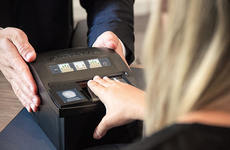
This Secure Fingerprinting Technique for Digital Documents is Cheap
Alyson Wyers — June 21, 2017 — Tech
References: ncl.ac.uk & springwise
This forgery-preventing fingerprinting technique can be used to affordably verify the legitimacy of documents. Developed by a team out of Newcastle University in the UK, the method involves taking a picture of a paper document with a regular camera, which will still be able to create an individualized digital fingerprint for the file.
Security engineering researcher Dr Feng Hao explains "What we have shown is that every piece of paper contains unique intrinsic features just as every person has unique intrinsic biometric features." The digital fingerprinting technique uses an ordinary source of light and a normal camera. The method only requires 1.3 seconds to capture these features, and will generate a corresponding textile fingerprint based on the snapshot.
Security engineering researcher Dr Feng Hao explains "What we have shown is that every piece of paper contains unique intrinsic features just as every person has unique intrinsic biometric features." The digital fingerprinting technique uses an ordinary source of light and a normal camera. The method only requires 1.3 seconds to capture these features, and will generate a corresponding textile fingerprint based on the snapshot.
Trend Themes
1. Forgery Prevention - The development of an affordable digital fingerprinting technique can offer disruptive innovation opportunities for companies specializing in document verification and authentication.
2. Intrinsic Feature Recognition - The use of unique intrinsic features to create digital fingerprints can offer opportunities for companies working on biometric verification and security systems.
3. Low-cost Document Verification - The development of a low-cost digital fingerprinting technique can offer opportunities for companies working in industries such as finance, legal, and healthcare that require secure and authentic document verification processes.
Industry Implications
1. Document Verification and Authentication - This digital fingerprinting technique can disrupt the way documents are verified and authenticated in industries such as legal, finance, and healthcare.
2. Biometric Verification and Security Systems - The use of intrinsic features to create digital fingerprints can offer disruptive innovation opportunities for companies specializing in biometric verification and security systems.
3. Financial Technology - The development of a low-cost digital fingerprinting technique can create opportunities for fintech companies working on secure document verification and authentication processes.
1
Score
Popularity
Activity
Freshness























